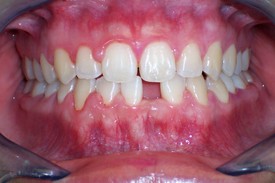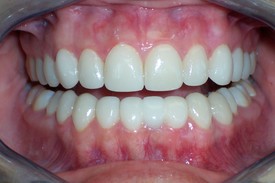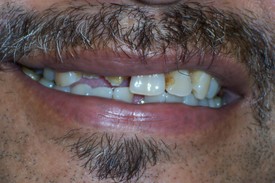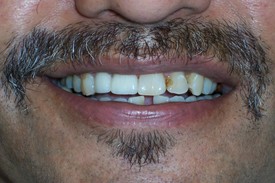
Before |

After |
A dental crown is a type of dental restoration that “caps” over a tooth to restore function and/or aesthetics. In contrast to a filling, a crown covers a larger portion of a tooth, providing more coverage and protection. A dental crown is used to restore the tooth to its original tooth shape, replacing large failing restorations, loss of natural tooth structure, or enhancing aesthetic appearance. Examples include a large cavity, decayed tooth, chipped/fractured teeth, a root canal treated tooth, or failing old fillings.
Crowns come in different shapes, sizes and materials; depending on the extent of damage to the tooth. In some cases a conservative ¾ size crown can be fabricated instead of a full coverage crown which requires more shaping and enamel removal. Choice of materials – metal alloy, gold alloy, porcelain, or a combination of both. There are advantages and disadvantages to these types. For example, a gold alloy crown provides good adaptation and does not break but being golden in color it lacks aesthetic value, whereas an all-porcelain crown is cosmetically pleasing but requires more tooth preparation work and usually higher cost.
Each crown is essentially custom made for the tooth. For our patients we determine and recommend what type of crown is best suited for them. Every patient is unique and may have specific needs, and we help our patients make the best choice for themselves.
Bridge;

Before |

After
|
A bridge is simply described as multi-unit crowns connected together. Using the adjacent teeth as support, the bridge spans over a lost tooth space and fills in with a “false” tooth. Bridge is traditionally used as a predictable restorative method to replace missing teeth. Since the advent of dental implants, bridges have really become a distant second as treatment of choice for replacement of missing teeth.
Many patients who do not clinically qualify for dental implants, have the choice of getting traditional bridges to restore function of missing teeth and in many cases aesthetic value of their smiles.